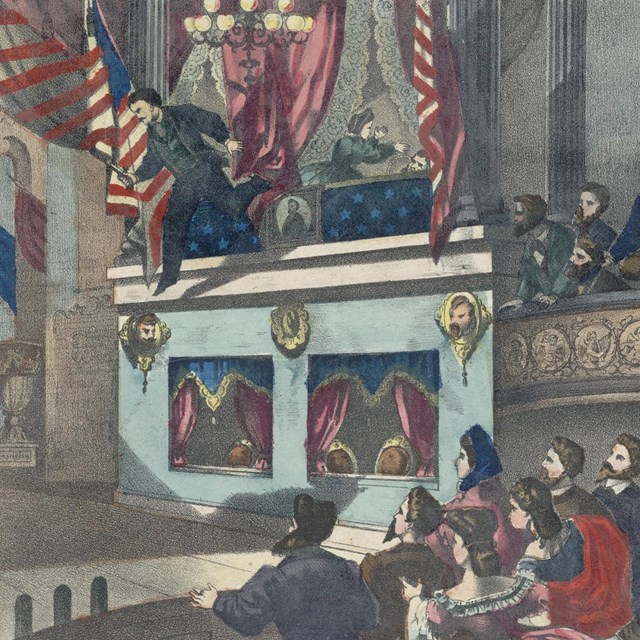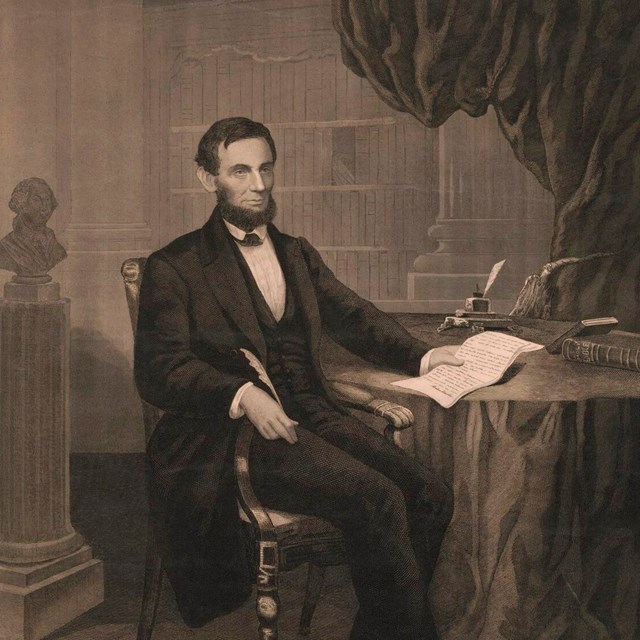
Brady-Handy photograph collection, Library of Congress Dr. Charles Augustus Leale: The Young Doctor Who Came to the Aid of a Slain PresidentCharles Leale was the first medical professional to treat President Abraham Lincoln at Ford’s Theatre. Leale had graduated with a degree in medicine just six weeks earlier from Bellevue Hospital Medical College in New York City. He was 23 years old.Born on March 26, 1842, in New York City, Leale had been around the medical profession since his early years. He received his first surgical instruction in the 1850s at the United States Marine Hospital in Portland, Maine where his father worked. At the time of the assassination, Leale was a commissioned officer in the medical department of US Army. and worked as the surgeon in charge of the wounded commissioned officers’ ward at the US Army General Hospital in Armory Square, Washington, DC. 
White House Historical Association A few days later, Leale heard that the president would be attending the theatre on the night of April 14, 1865. He purchased a ticket in the hopes of getting another glimpse of the great man. Leale gave seven known accounts of his experiences that night. Five date from 1865, one from 1867, and one from 1909. The variations among the accounts are minimal. His recollections featured in this article come from the only time that Leale ever spoke in public about the events of that terrible night. This occurred on the 100th anniversary of Lincoln's birth in 1909. Leale addressed the New York commandery of the Military Order of the Loyal Legion of the United States, a major Union veterans' organization. 
National Park Service “Suddenly there was a cheering welcome, the acting ceased temporarily out of respect to the entering Presidential party. Many in the audience rose to their feet in enthusiasm and vociferously cheered, while looking around. Turning, I saw in the aisle a few feet behind me, President Lincoln, Mrs. Lincoln, Major Rathbone and Miss Harris. Mrs. Lincoln smiled very happily in acknowledgment of the loyal greeting, gracefully curtsied several times and seemed to be overflowing with good cheer and thankfulness. I had the best opportunity to distinctly see the full face of the President, as the light shone directly upon him." "After he had walked a few feet he stopped for a moment, looked upon the people he loved and acknowledged their salutations with a solemn bow. His face was perfectly stoical, his deep set eyes gave him a pathetically sad appearance. The audience seemed to be enthusiastically cheerful, but he alone looked peculiarly sorrowful, as he slowly walked with bowed head and drooping shoulders toward the box. I was looking at him as he took his last walk. The memory of that scene has never been effaced.” 
Library of Congress “The theatre was well filled and the play of “Our American Cousin” progressed very pleasantly until about half past ten, when the report of a pistol was distinctly heard and about a minute after a man of low stature with black hair and eyes was seen leaping to the stage beneath, holding in his hand a drawn dagger. I then heard cries that the ‘President had been murdered’…I immediately ran to the Presidents box and as soon as the door was opened was admitted and introduced to Mrs. Lincoln when she exclaimed several times, ‘O Doctor, do what you can for him, do what you can’!” Leale was sitting only 40 feet from the state box when he saw John Wilkes Booth jump onto the stage, waving a dagger. He sprang into action and made his way towards the president. Leale became the first physician to reach the wounded Abraham Lincoln. The doctor found him “seated in a high-backed arm-chair with his head leaning towards his right side supported by Mrs. Lincoln, who was weeping bitterly.” Lincoln was unconscious, paralyzed and barely breathing. "His eyes were closed and he was in a profoundly comatose condition, while his breathing was intermittent and exceedingly stertorous." Because Leale had seen the murderer on stage with a knife, he assumed that the President had been stabbed. He laid the president down on the floor and removed his shirt, but he did not see any gashes. Upon further examination, he discovered "a large clot of blood about one inch below the superior curved line and an inch and a half to the left of the median line of the occipital bone in the back of the skull." This was the entry point of the bullet. Leale used his finger to open up the blood clot, temporarily restoring the president's pulse and breathing. Still, the young doctor knew that Abraham Lincoln would not survive this injury. Leale’s diagnosis went out on telegraph wires around the country: “His wound is mortal; it is impossible for him to recover.” 
Library of Congress With the help of a group of soldiers, Leale supervised the move of the dying president out of Ford’s Theatre. Once in front of the theatre, among a large crowd of people, they looked for a place to take him. Directly across the street from Ford’s Theatre was the Petersen Boarding House. Henry Safford, a resident there, came out of the front door and stood on the landing, trying to determine what all the noise was about. He realized that a party of men was President Lincoln, looking for a place to go. Safford yelled to Leale and the soldiers to “bring him in here, bring him in here.” Throughout that terrible night, Leale sat by the bedside and held the president's hand. He believed that "sometimes, recognition and reason return just before departure. I held his hand firmly to let him know, in his blindness, that he had a friend." Abraham Lincoln remained unconscious for approximately nine hours before passing away at 7:22 the next morning. 
United States National Library of Medicine “I left the house in deep meditation. In my lonely walk I was aroused from my reveries by the cold drizzling rain dropping on my bare head, my hat I had left in my seat at the theatre. My clothing was stained with blood, I had not once been seated since I first sprang to the President’s aid; I was cold, weary and sad. The dawn of peace was again clouded, the most cruel war in history had not completely ended.” Charles Leale continued to serve in the army until 1866 when he was discharged as a brevet captain. He then returned to his home town of New York City, where he established a successful private practice. He married Rebecca Copcutt on September 3, 1867, and the couple had six children. Leale lived a long and productive life of 90 years and died on June 13, 1932. He was one of the last surviving witnesses present at Lincoln's assassination. Charles Leale is buried in Oakland Cemetery in Yonkers, New York. Want to Learn More?
|
Last updated: August 14, 2025



